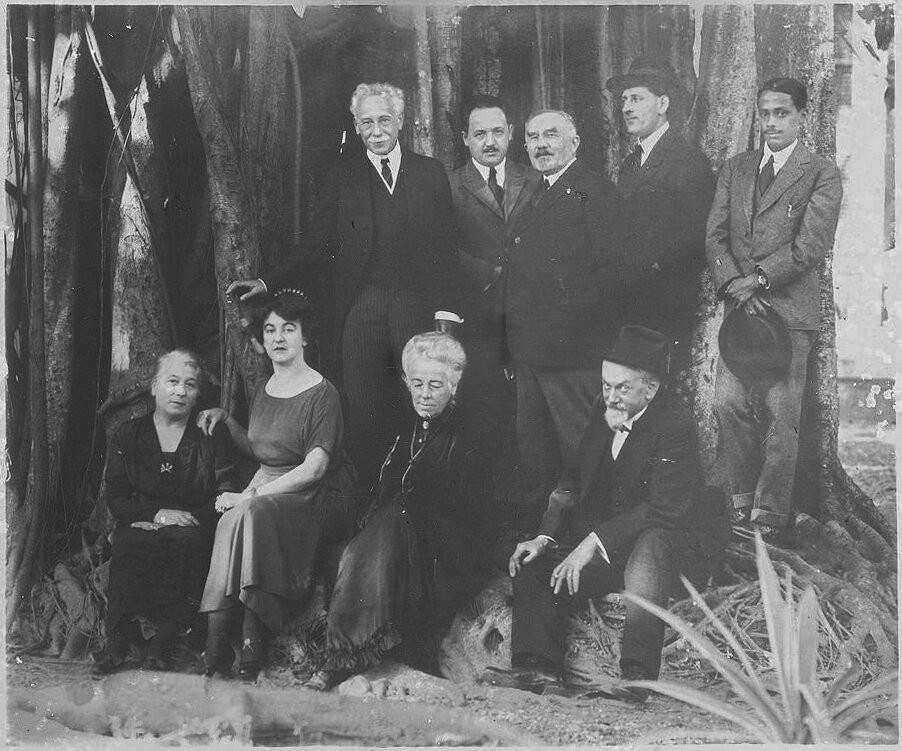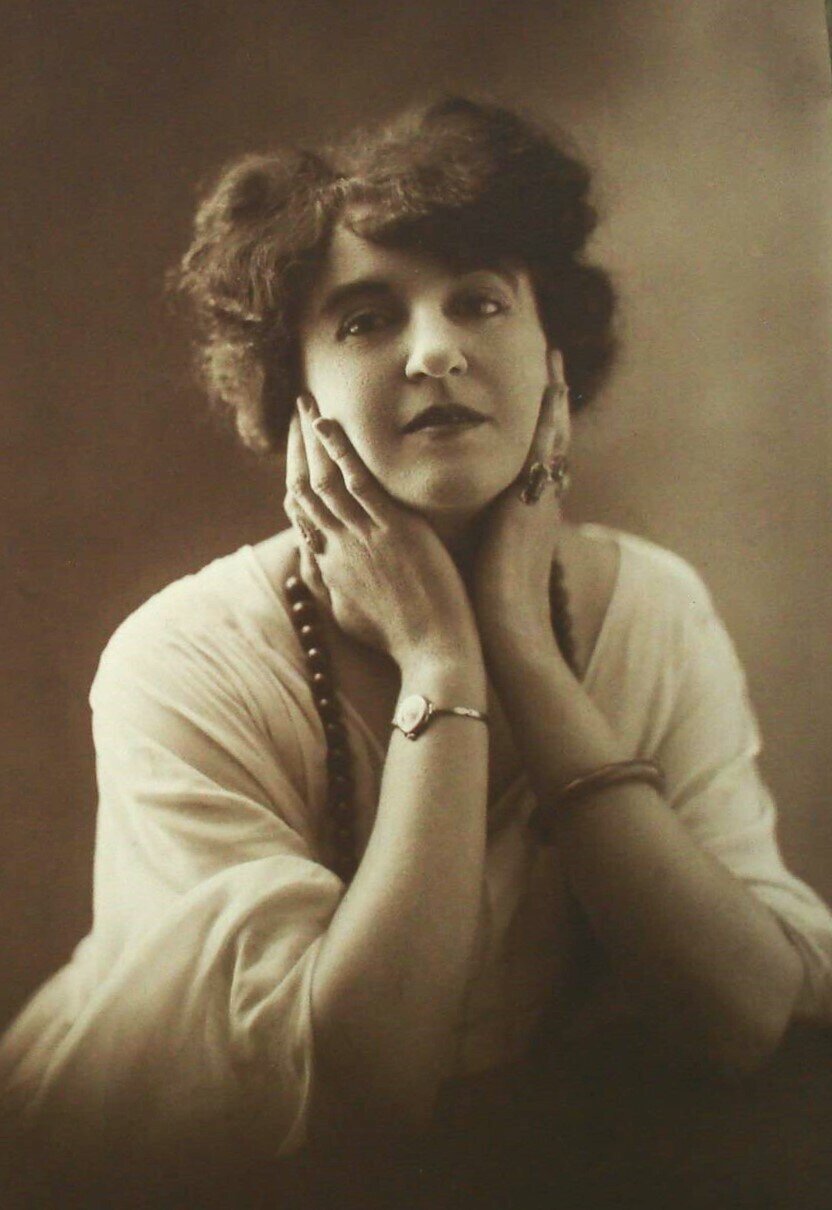Jeanne Leuba

Journalist, novelist and poet Jeanne Leuba (8 Nov. 1882, Paris – 24 July 1979, Pettenbach, Austria) depicted in her novels the status of local and expatriate women in colonial Indochina, while getting involved into archaeological and historic research after marrrying EFEO director Henri Parmentier in 1905.
Trained in her youth to become a concert pianist, Jeanne Leuba traveled together with Parmentier to the remotest places around Cambodia and Annam, publishing an essay about the ruins of Angkor as early as 1914, and several studies about the Cham ethnic minority. As a poetess, she was recognized after the 1913 publication of Tristesse du soleil, and poet and translator René Crayssac (18 Sept. 1883 — 22 June 1940) devoted her a long and enthusiastic portrait (under the pen name of Mat Giang in Revue indochinoise, July 1917), praising her talent and noting that she was “brune, plus que jolie, vraiment belle” [“a more than pretty, really beautiful brunette”].
Recognized by Louis Malleret as ‘one of the two major women colonial writers’ about Indochina (with Clotilde Chivas-Baron), she set in Angkor part of the storyline for her highly-praised novel, L’Aile du feu (1920). In 1945, she was detained in the same Japanese concentration camp where famous Khmerologist George Groslier was going to perish. After Parmentier’s death in 1949, she decided to remain in Cambodia, working for local French-language newspapers and Phnom-Penh Radio. In 1959, she published in Phnom Penh ‘Angkor, Guide Parmentier’ (EKLIP Publishers, with photographs by Robert Dalet, Guioneaud and Manikus (EFEO photographers and researchers)). She left Cambodia in 1966, at 84 years of age, settling in Austria until she passed away in 1979.
Bookseller and collector Francois Doré (Librairie du Siam, Bangkok, Thailand), has recovered more than 40 short stories and tales authored by Jeanne Leuba before 1949, including two novels in which the author describes with caustic humor the amorous and sexual dalliances of French expats in the 1930s, Le métis ensorcelé (Saigon, Edition J. Aspar, 1941) and Panique (id,1942). Ecumes... was her last published novel (Saigon, 1943), while she had celebrated Cambodia’s mysterious beauty in La Breve Lumiere (Saigon, 1930).

Jeanne Leuba in the gardens of Hanoi EFEO headquarters in Hanoi, late 1922, seated with Désirée Sylvain-Lévi (S. Lévi’s wife) to her right, and on her left Miss Lulius van Goor and husband Henri Parmentier. Standing behind, from left to right, Sylvain Lévi, Léonard Aurousseau, Louis Finot, Paul Demiéville and P.C. Bagchi. [coll. EFEO]
Jeanne Leuba in the gardens of Hanoi EFEO headquarters in Hanoi, late 1922, seated with Désirée Sylvain-Lévi (S. Lévi’s wife) to her right, and on her left Miss Lulius van Goor and husband Henri Parmentier. Standing behind, from left to right, Sylvain Lévi, Léonard Aurousseau, Louis Finot, Paul Demiéville and P.C. Bagchi. [coll. EFEO]
Jeanne Leuba’s entry in Brebion-Cabaton’s Bibliogaphical Dictionary: “Elle épousa à Paris, en 1905, Henri Parmentier, architecte diplômé de l’Ecole nationale des Beaux-Arts de Paris, attaché à l’Ecole française d’Extrême-Orient. Elle accompagna son mari dans ses différentes missions archéologiques en les divers pays de l’Union indochinoise. Elle s’éprit du pays, de ses sites; elle étudia les moeurs et les coutumes de ses habitants et sur ce qu’elle vit et observa, elle publia des poésies délicates, de charmantes et très vécues nouvelles, notamment dans la Revue indochinoise d’Hanoï, les Pages, la Plume indochinoise, etc.: La baie d’Along, Revue indochinoise (2e sem. 1910); Le pèlerinage des sept pagodes (Rev. indoch., 1911 ); La tristesse du Soleil. Paris, Plon, 1913; Les Chams d’autrefois et d’aujourd’hui (Rev. indoch., juillet-août 1915).” [“In 1905, she married in Paris Henri Parmentier, architect graduated from the National School of Fine Arts in Paris, attached to the French School of the Far East. She accompanied her husband in his various archaeological missions around the Indochinese Union. She fell in love with the country, its sites, she studied the manners and customs of its inhabitants, and on what she saw and observed, she published precious poems, charming and lively short stories, notably in the Indochinese Review of Hanoi, the Pages, the Plume Indochinoise, etc.”]
Interestingly, Jeanne Leuba did not get the Prix des Français d’Asie in 1931, the award (and the 25,000 francs grant) going to novelist Herbert Wild. According to the periodical L’Avenir du Tonkin (4 May 1931), “au premier tour de scrutin Mme Chivas-Baron avait voté pour Mme Leuba ; Roland Dorgelés pour Roubaud ; Ajalbert et Pierre Benoit pour Malraux. B. de Bellevaut commente dans Indochine ce vote : “A notre très humble avis, le jury né pouvait hésiter qu’entre Jeanne Leuba et Jean Marquet, qui sont des romanciers de race. Oui, et puis, ils n’ont pas, comme l’un des candidats, rendu les plus mauvais services à l’Indochine. » Si le gouverneur général pouvait encore trouver quelques piastres pour un second prix, on pourrait I attribuer, toujours par voie d’élection, au journaliste ou au romancier ayant fait le plus de mal à la colonie dont il attend l’argent.” [“in the first ballot Ms. Chivas-Baron had voted for Ms. Leuba; Roland Dorgelés for Roubaud; Ajalbert and Pierre Benoit for Malraux. B. de Bellevaut comments in Indochina on this vote: “In our very humble opinion, the jury could only hesitate between Jeanne Leuba and Jean Marquet, who are thoroughbred novelists. Yes, and then, like one of the candidates, they did not do the worst service to Indochina. “If the governor general could still find a few piastres for a second prize, it could be awarded, again by election, to the journalist or novelist who has done the most harm to the colony from which he expects the money.”
We can see here some “gender war” dynamic, with Jean Ajalbert and Pierre Benoit pushing for macho André Malraux, who had just published his provocative novel La Voie Royale (The Royal Way, or The Way of the Kings, 1930) inspired by his own infamous attempt at stealing statues from the Banteay Srey temple, while Clotilde Chivas-Baron stood for Jeanne Leuba.
Publications
- “Y a‑t-il des sorciers? Y en a‑t-il encore?” and “Sonnet de minuit”, Ernest d’Hauterive, Jeanne Leuba, ed. Felix Juven, Le Monde Moderne vol. 18, 1903
- “La lavandiere”, in Le Petit Parisien, May 1905
- “La baie d’Along”, in Revue indochinoise, Hanoi, 2sd sem. 1910
- “Nostalgie”, in Revue indochinoise, Hanoi, XV‑1, 1911
- “Prime aube”, in Revue indochinoise, Hanoi, XVI-11, 1911
- “Tryptique”, in Revue indochinoise, Hanoi, XVI-12, 1911
- “Le pèlerinage des sept pagodes”, in Revue indochinoise, Hanoi,1911
- La Tristesse du soleil, Plon-Nourrit et Cie, 1913
- Les Ruines d’Angkor, Imprimerie administrative, 1914
- “Les Chams d’autrefois et d’aujourd’hui”, La Revue Indochinoise, 1915
- “Pour un bijou”, La Revue Indochinoise, 1917
- L’Ombré nuptiale, Plon-Nourrit et Cie, 1919
- “Loin du monde”, La Revue Indochinoise, juin 1919, p. 563 – 573
- L’Aile de feu, Paris, Plon-Nourrit, 334 p. (ISBN 0274948915)
- “Adieux”, in Moniteur d’Indochine n 238, Sept. 1923
- “La lecon de courage”, in Moniteur d’Indochine n 241, Sept. 1923
- “La pierre des dieux”, in Moniteur d’Indochine n 243 – 244, Oct. 1923
- Erick en exil, Paris, Perrin, 1923, 310 p.
- Un royaume disparu. Les Chams et leur art, G. Van Oest et cie, 1923 (Pref. Louis Finot)
- “Etudes indochinoises”: Le Laos”, Revue des Etudes indochinoises du tourisme et de l’automobile, Hanoi, n 130 – 132, Nov. 1925
- “La fin d’un roi cambodgien. Incineration de S.M. Sisowath”, in Extrême-Asie, n 22, 1st Apr. 1928 (with photographs by Maurice Debeaupuis)
- La Brève lumière, E. Flammarion, 1930
- “Le Personnel reconnaissant”, Le Petit Écho de la Mode, n 37, 10 Sept. 1933
- “Dans l’ombré des jours”, in Lisez-Moi n 404 and n 406 (Taillandier), Paris, 1939
- Le Métis ensorcelé (La Roué du temps. Condiments. Les Deux nuits de l’as de trèfle. Camille ou l’ingénue malgré lui), J. Aspar, Saigon,1941
- Le Mystère de Bel-Abri (Le Rubis volé. La Servante des Aiguilles), J. Aspar, Saigon, 1942
- Écumes, J. Aspar, Saigon, 1943, 264 p.
- L’Art du Laos (with Henri Parmentier), Paris, Imprimerie Nationale (Publications de l’École Française d’Extrême-Orient), 1954, 223 p. (ISBN 2855395429)
- Angkor. Guide Henri Parmentier (with Henri Parmentier), E.K.L.I.P, 1960 (Albert Portail, Saigon,1950)
- “Le Mystere de la Plaine des Jarres”, in Nouvelles Litteraires, Apr. 1961, 1 p.
- “Lettre de Jeanne Leuba au Premier mnistre français Raymond Barre sur l’erreur de jeunesse, il y a presque 100 ans, d’un grand écrivain français au Cambodge [dated Ezhenthof 23 Jan. 1977, published in 2016 on Thong Hoeung Ong’s blog.]
- Related Books

